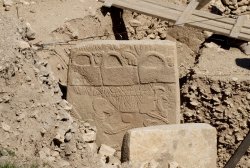PLANNING TO GO TURKEY?
Find the best Tour in Turkey...
TURKEY TRAVEL GUIDE
GOBEKLITEPE
Gobeklitepe "The First Temple Of The World
Approximately 12.000 years ago, the area of land between the Euphrates and Tigris rivers, 17 km away from Şanlıurfa, was the site of the most important change in the history of mankind. The hunter-gatherer lifestyle of man was beginning to evolve into a more settled herder-farmer way of life. The remains found at Göbekli Tepe show us that life during this period of change, thousands of years ago, was not the simple, unsophisticated life that we thought.Göbekli Tepe, a cult centre created by its hunter-gatherer people, commands a view reaching view due to the topographical characteristics of its location. The site lies at the highest point of the range of mountains that forms the northern border of the Harran Plain. Archaeological research models and theories of the Neolithic Age have been turned upside down by new data from the Göbekli Tepe site. At a time approaching the change to a herder-farming life the monumental architecture and the advanced symbolic world of these last hunter-gatherer groups demonstrate a completely unexpected level of culture and civilization for that time.
Göbekli Tepe is composed of 20 round and oval structures reaching 30 m in diameter. Of these, 6 have been exposed through excavation, the rest have been mapped using geomagnetic and georadar survey methods. The result of these excavations and surveys show that Göbekli Tepe was chosen and created by its people nearly 12.000 years ago as a major meeting centre. The monumental structures were built for ceremonial purposes, not to provide areas for daily living.
In the centre of these circular structures there were two T-shaped, free-standing limestone pillars which were roughly 5 m in length. Smaller versions of these pillars were placed around the inside walls and were directed towards the central pillars. The animal motifs and various abstract symbols carved on the pillars seem to point to some kind of a communication system; the symbolic world, memory and messages of 12.000 years ago.
The impressive monumental findings at Göbekli Tepe reflect at a competent level of stonework, and the rich content of carved motifs show that a level of complex thought processing had been reached. Aside from all these findings, when the quality and quantity of the structures are considered, it becomes apparent that to achieve such a construction required an understanding of large dimensions, monumentality, and numberical density, gained not by systematic repetition. These would have been supported in the background by skills in organization and coordination, and a developed social system.
The monumental structures of Göbekli Tepe were deliberately buried by the Neolithic people who built them. It almost seems that the burial was a planned part of the construction right from the beginning.
Approximately 10.000 years ago, the use of Göbekli Tepe came to an end. During this time, the last hunter-gatherers were beginning to change their way of life. By burying the site, they abandoned their old identities, their important beliefs and their symbolic world without destroying it. Therefore, this unique place of worship, this isolated, remote, and peaceful mountain meeting centre, has survived without damaged to the present day.
For nearly 2.000 years ago, Göbekli Tepe played an important role in the ritual world and lives of the local people until it was abandoned by the last hunter-gatherers. From that day until 1995 it lay waiting to be rediscovered.
The earliest reference to the name Göbekli Tepe appears in a 1980 publication of archaeological research. The site was discovered in 1963 during a surface survey carried out jointly by the Universities of Istanbul and Chicago. The first details of the settlement were mentioned in an article on the surface surveys written by Peter Benedict in 1980.The article contained a short description of Göbekli Tepe, noting the abundance of flintstones found on its slopes and the presence of possible burial sites at the top of the two highest mounds. However, the knowledge at that time regarding the Neolithic Age meant that Göbekli Tepe was not recognized as a special site. The first large statues and T-shaped pillars dating from the same period hade been discovered in the Nevali Cori excavation near Urfa in the 1990s. In 1994, Klaus Schmidt, an archaeologist who had worked on Nevali Cori excavation, visited the site of Göbekli Tepe. Work at Nevali Cori site was finished, and the area had been flooded with water from the Atatürk Dam, so Klaus Schmidt was looking for new project amongst the area’s known Neolithic settlements. Using the experience that he had gained from the Nevali Cori excavation, Klaus Schmidt was able to recognize the stones at Göbekli Tepe as the tops of Neolithic pillars, not burial sites as the previous researchers had thought. Prof.Dr. Klaus Schmidt, an expert at the Orient Department of the German Archaeological Institute in Berlin, and professor at Erlangen University, has been continuously involved in the work at Göbekli Tepe since 1995.
When the astounding findings first appeared as a result of the excavation, they very quickly attracted world-wide attention. According to statistics produced by the excavation team, since 2010, during the months of September and October, an average of 300 people have visited Göbekli Tepe every day. The excavation has appeared on the front cover of several international magazines, and is attracting more and more local and foreign tourists to Sanlıurfa.



